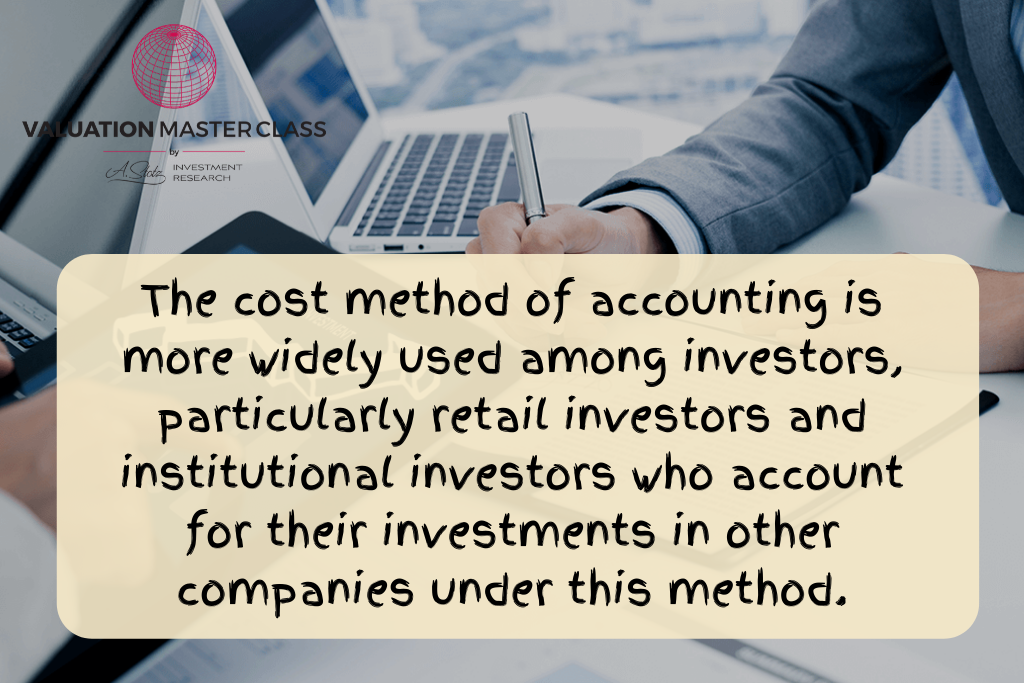Accounting of Investments in the Balance Sheet
This is a Valuation Master Class student essay by Jiten Dialani from May 14, 2018. Jiten wrote this essay in Module 4 of the Valuation Master Class.
According to International Financial Reposting Standards number 10:7, “An investor controls an investee if and only if it has the following elements:
- Power over the investee, i.e. the investor has existing rights that give it the ability to direct the relevant activities (the activities that significantly affect the investee’s returns)
- Exposure, or rights, to variable returns from its involvement with the investee
- The ability to use its power over the investee to affect the number of the investor’s returns.”
A power arises from rights. Rights can be voting rights or out of contractual arrangements. A parent must not only have power over an investee and rights to variable returns but also must have the ability to exercise its power over investee by affecting its returns out of its involvement. When companies acquire a stake over another company, there are two accounting methods that could be used: cost method and equity method. The cost method is used when a company does not exert a significant influence over another company whereas the equity method is used when a company exerts a significant influence or control over another company. Following is an overview of the 2 methods and examples to illustrate them.
Cost Method
The cost method is used when a company does not exert a significant influence over another company; usually, the shareholding percentage is capped at a maximum of 20% to determine the extent of control. Investments in equity shares of the investee company leading to the holding of less than 20% are generally accounted for under this method. Under this method, the investments in the stocks are recorded at cost of purchase and are not modified until the shares are sold. Dividends earned from the investment are recorded as income in profit and loss account and are accounted for in the calculation of tax. For example, if company A acquires a 5% stake in company B by buying 1,000,000 equity shares @ US$ 5 each, then the investment cost of US$ 5,000,000 is recorded as an investment in company A’S balance sheet. The investment value remains unchanged regardless of fluctuations in the market price of stocks of company B. The dividend received from company B out of the shareholding is recorded as income in the profit and loss account.
Equity Method
The equity method is used when a company exerts a significant influence or control over another company; usually, the shareholding percentage is capped between 20% and 50% in order to qualify for the equity method of accounting. Under this method, the investment is initially recorded in the same manner as the cost method, but the amount is subsequently adjusted as per the investee company’s profits or loss by applying the shareholding ownership percentage. Dividends are accounted for as return on investment and reduce the listed value of shares. For example, if company A acquires a 40% stake in company B by buying 8,000,000 million equity shares @ US$ 5 each, then the investment value is recorded initially at cost in the balance sheet. Subsequently, if company B generates US$ 20 million as net profits for the financial year, then company A would apply 40% of the net profit amount which is US$ 8 million to add to the listed value and record the net profit amount as income. If company B announces a dividend of US$ 0.20 per share then the dividend amount of US$ 1,600,000 (8,000,000 shares held x US$ 0.20) reduces company A’s investment value since dividends reduce the equity of company B.
Difference Between Cost Method and Equity Method
The cost method of accounting is more widely used among investors, particularly retail investors and institutional investors who account for their investments in other companies under this method. Usually, the retail investors or institutional investors would look only for capital gains or regular income in the form of dividends while investing and would not generally look to buy stocks in larger quantities so as to get a controlling stake over the company. The equity method is used mainly by corporations who, due to strategic or goal-oriented reasons invest a considerable stake in another company which gives them influence over the board and decision making of the investee company. Under the cost method, the investment value remains unchanged in the books, whereas under the equity method, the value is initially recorded at cost, but is subsequently adjusted for the gains/losses of the investee company according to the parent company’s shareholding percentage. Since the value of investment falling under cost method is lesser, the investment value is not tied to the performance of the investee company, but in case of the equity method, since the value of the investment is more significant resulting in greater influence, the investment value is tied to the performance of the investee company. In the case of cost method, dividends are recorded separately as income in the profit and loss, whereas in the case of the equity method, dividends lower the investment value as dividends reduce the investee company’s equity.
Conclusion
Both cost method and equity method accounting methods are used by the investors based on their percentage of shareholding in the investee company and based on the extent of influence that can be exercised to affect the investee company’s operating results. The cost method is more widely used on account of the significant investments being made by common retail investors and institutional investors, whereas the equity method is usually used by companies or large corporations when they acquire a controlling stake in the investee company as per their operating strategy or goals. As per popular Investment consultants, The Motely Fool, “The Cost method is by far the most common approach for reporting investment gains and losses.”
